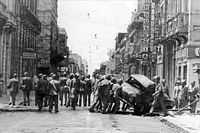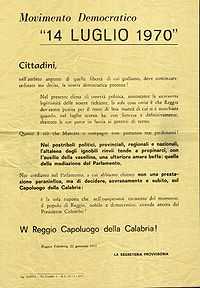Reggio revolt


The Reggio revolt occurred in Reggio Calabria, Italy, from July 1970 to February 1971. The cause of the protests was a government decision to make Catanzaro, not Reggio, regional capital of Calabria.[1][2] The nomination of a regional capital was the result of a decentralization programme of the Italian government, under which 15 governmental regions were created and given their own administrative councils and a measure of local autonomy.[3]
History
When in July the much smaller town of Catanzaro (with a population of 82,000 against 160,000 in Reggio) was chosen Reggio exploded. On July 14, a general strike was called in protest. Five days of street violence left one dead and several policemen injured.[3][4] A force of 5,000 armed police and carabinieri was moved into the area. The government ordered state-owned TV not to carry any news of the insurrection. However, the revolt steadily picked up steam and sympathy.[3]
Prolonged road and rail blockages damaged the whole country. Strikes, barricades and wrecked tracks forced trains from the north to halt two hours short of Reggio. The Highway of the Sun, Italy's main north-south autostrada, was sealed off. When the port was blocked, hundreds of trucks and freight cars stood idle on the other side of the Straits of Messina.[3]
The revolt was taken over by young neofascists of the Italian Social Movement (Movimento Sociale Italiano – MSI) backed by the 'Ndrangheta, a Mafia-type criminal organisation based in Calabria.[1][5] Francesco Franco, a trade union leader from the CISNAL labour union close to the neofascist movement became the informal leader of the revolt. "Boia chi molla" (Death to him who gives up) was the right-wing rallying cry during the revolt.[6]
On July 22, 1970, a bomb exploded on "Treno del Sole", the Palermo-Turin train, in the Calabrian city of Gioia Tauro, killing 6 persons and wounding 136. The Gioia Tauro massacre was linked to the revolt. In 1993, the former member of ‘Ndrangheta Giacomo Lauro said he had supplied the explosives to people linked to the leaders of the revolt.[4]
On February 23, 1971, armored cars entered the Sbarre neighbourhood and finally suppressed the revolt. According to official figures of the Italian Ministry of the Interior there were 3 dead, and 190 policemen and 37 civilians wounded. Other sources mention 5 dead and hundreds of wounded. The so-called Colombo Package (named after then Prime minister Emilio Colombo) offering to build the Fifth Steelwork Centre in Reggio, an investment of 3 billion lire which world create 10,000 jobs, softened the people of Reggio and helped to quell the revolt.[6]
Catanzaro and Reggio Calabria became Calabria's joint regional capitals, Catanzaro as the seat of the regional administration and Reggio Calabria as the seat of the regional parliament.
See also
References
- ↑ 1.0 1.1 Paoli, Mafia Brotherhoods, p. 198
- ↑ Partridge, Italian politics today, p. 50
- ↑ 3.0 3.1 3.2 3.3 No Saints in Paradise, Time Magazine, Oct. 26, 1970
- ↑ 4.0 4.1 (Italian) La brutta avventura di Reggio Calabria, La Repubblica, January 5, 2008
- ↑ Town the mafia shut down, The Independent, 4 February 1996
- ↑ 6.0 6.1 La Rivolta di Reggio Calabria, Archivio'900
- Paoli, Letizia (2003). Mafia Brotherhoods: Organized Crime, Italian Style, New York: Oxford University Press ISBN 0-19-515724-9 (Review by Klaus Von Lampe) (Review by Alexandra V. Orlova)
- Partridge, Hilary (1998). Italian politics today, Manchester: Manchester University Press, ISBN 0-7190-4944-X
- Polimeni, Girolamo (1996). La rivolta di Reggio Calabria del 1970: politica, istituzioni, protagonisti, Pellegrini Editore, ISBN 88-8101-022-4
External links
- I giorni della rabbia - La rivolta di Reggio Calabria, La Storia siamo noi - Rai Educational